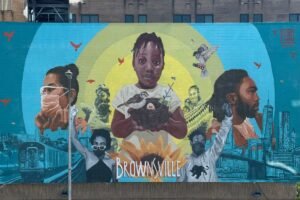
Having worked in the social sector for a little over a decade, I have firsthand experience with the art and science of getting social impact programs off the ground. Towards the tail end of 2020, I was hired by Newark, New Jersey, to launch the city’s inaugural two-year guaranteed income pilot program and led the program for its first year. During this period, some important lessons about how to develop a successful pilot program emerged.
Guaranteed income is an unconditional, recurring cash grant given directly to income-qualified individuals—no strings attached and no work requirements. Though related to universal basic income (UBI), it is not the same. UBI grants are universal and require no means testing. In contrast, guaranteed income gives cash to people living below the poverty line or with inconsistent or no income and entails a qualifying process. It is nonetheless considerably less bureaucratic than typical social safety net policies in that it provides a steady, predictable stream of cash to recipients to spend however they see fit.
In 1967, Dr. Martin Luther King advocated for guaranteed income as the simplest and most effective solution to poverty.
Financially insecure households can effectively use such cash to address their short- and long-term needs. Guaranteed income respects the dignity of those receiving it, freeing recipients to navigate their own unique situations. It is not a substitute for work. It is meant to supplement, rather than replace, the existing social safety net and job sector and can be a critical tool for improving racial and gender equity.
In 1967, Dr. Martin Luther King advocated for guaranteed income as the simplest and most effective solution to poverty. The Black Panther Party, Detroit civil rights leader and labor activist , and the National Welfare Rights Organization were also proponents of using guaranteed income to address poverty, while feminists in the Wages for Housework movement in the 1970s proposed using guaranteed income to counter the male breadwinner model.
President Lyndon B. Johnson’s Office of Economic Opportunity launched a series of basic income experiments in the 1960s. A three-year pilot program, called the New Jersey Graduated Work Incentive Experiment, was carried out in Trenton, Passaic, Paterson, and Jersey City. The program granted participating low-income families $4,352 a year (approximately $30,000 today). Notably, there was no widespread withdrawal from work by program recipients.
Today, several guaranteed income pilot programs have been launched in response to economic inequities that the COVID-19 pandemic exposed and exacerbated. In 2018, Stockton, California’s then-Mayor Michael Tubbs announced the first citywide guaranteed income program in the country, the Stockton Economic Empowerment Demonstration, or SEED. Launched in 2019, SEED randomly selected 125 Stockton residents, who received $500 a month for two years. In 2021, San Francisco launched a six-month pilot program, called Miracle Money, which distributed $500 a month to 15 people experiencing homelessness in the city.
The Magnolia Mother’s Trust, now the longest-running guaranteed income pilot program in the United States, was launched in 2018. The program distributes $1,000 a month to 100 Black mothers in Jackson, Mississippi.
As we begin to glean more data from participants of guaranteed income pilot programs, it is important to understand how such programs can be implemented.
Designing a Successful Guaranteed Income Strategy: Ten Key Elements
Below, I highlight ten components of a successful launch of a guaranteed income pilot program, based on my experience in Newark, New Jersey. These components can be employed through a nonprofit organization or city government.
- Political will from key decision-makers: A commitment from key leaders to invest in the program’s launch sends a message to the greater community that people have a vested interest in seeing the program to fruition. Without this step, it is difficult to secure community members’ trust in the program and, consequently, their participation in the community engagement process.
When identifying key decision makers, be mindful of the environment in which the program is set to occur. For example, at a nonprofit, key decision makers might include the organization’s board members and staff. Board members will be responsible for approving the plan to execute a pilot program, influencing the pilot program’s design, and leveraging resources to bring the idea to life. Staff may be responsible for leveraging resources to launch the program and participating in various stages of its implementation.
Sign up for our free newsletters
Subscribe to NPQ's newsletters to have our top stories delivered directly to your inbox.
By signing up, you agree to our privacy policy and terms of use, and to receive messages from NPQ and our partners.
In city government, key decision makers may include the mayor, city council members, the housing authority, and other public service representatives. In Newark’s case, the mayor’s commitment to launching a guaranteed income program facilitated passage of a city council resolution to launch a city-led pilot. Gaining buy-in from key decision makers is important as they can help program staff navigate complex webs of regulations and ensure that the program design mitigates potential conflicts between the pilot and existing public assistance programs. When the right leaders publicly support a guaranteed income pilot program, it helps build community trust and makes it easier to navigate a complex policy environment.
- Community buy-in: An ongoing commitment to ensuring that the community remains fully aware of the pilot program and its progress throughout its lifecycle is key to success. Ensure that community feedback and concerns are acknowledged and addressed well before the launch of a pilot program and certainly well before the program’s parameters are solidified. Community buy-in means facilitating deep community conversations to determine how to construct program guidelines and preemptively address residents’ concerns.
It can be easy to make the mistake of presenting an established plan to the community at the point where changes are no longer possible. In my case, feedback had been gathered from the community before I assumed the role of program lead. I combined this feedback with additional findings from paid focus groups to understand what community members felt about the program’s design after I took on my position. This exposed me to different residents’ concerns, and naturally, residents—along with other stakeholders—had many questions about the selection process.
Establishing community buy-in early on helped me understand how to best communicate the program’s nuances to ensure that the selection process was transparent. Making it clear that participants would be randomly selected by a separate research team (and not by myself or city representatives) was critical in building trust among all stakeholders.
Having such conversations consistently and in a manner that is accessible to all is an essential part of the community buy-in process. To ensure that these conversations were accessible, the Newark program established a mobile-friendly website translated into languages spoken in the community; created a social media presence; and held Zoom meetings accompanied by Spanish, French, and Portuguese speaking translators leading up to the program’s launch. These mechanisms allowed the city to update community members about the program at the early stages of its development. Community buy-in requires constant work, and developing a transparent process was key to furthering this goal.
- An experienced research partner: Having a solid research partner will help the program to develop a set of research questions that make the case for translating the pilot into policy. While the pilot program’s aim is to provide direct monetary support to recipients, it is also about creating narrative change and challenging public perceptions about the efficacy of cash as a social benefit. Collecting data points about the program’s impact will support this goal. In Stockton, California, one key finding that helped to challenge public perception about guaranteed income programs was that a guaranteed income helped recipients find full-time employment, rather than encouraging them to work less.
Depending on budgetary constraints, a program might opt to partner with a local university or independent research firm. As the research partner will be responsible for soliciting input from program participants, it is important to select partners who understand the nuances of working with the community in which the pilot is set to occur. In Newark, we had the advantage of partnering with the University of Pennsylvania through its Center for Guaranteed Income Research. This partnership allowed the city to hire local research associates who were responsible for contacting program participants and ensuring surveys were completed on time by members of the control group and program recipients.
- A guaranteed funding source: Identifying a funding source is critical to cementing an organization’s commitment to launching a pilot program. Some cities have used funding from the American Rescue Plan Act to launch their respective pilot programs.
Grants and individual donations can also help to seed funding for a pilot program. One nuance, however, is that the funding source may influence the program’s parameters as eligibility criteria will likely need to align with funder stipulations. Once the funding source has been identified, the program must clearly communicate how and whether this may impact eligibility criteria.
- An accessible application process: If a pilot program stipulates that individuals wishing to participate must apply, then the application must be accessible to interested parties. Promoting accessibility might mean making the application available in multiple languages and mobile friendly. In some instances, local libraries may be key partners in ensuring access. In Newark, while I was not allowed to publicly preview the application in advance, I was able to inform potential applicants that it was lengthy. Knowing this allowed applicants to make provisions and identify friends or family members to help them apply.
- A trusted financial disbursement partner: A bank, credit union, or other financial institution will be responsible for distributing funds to program recipients. This partner will also need to collect data about program participants’ spending habits for evaluation purposes. Depending on how this spending data is accessed, the partner can further gain recipients’ trust or elicit suspicion. During the community engagement process in Newark, I made it a point to understand residents’ preferences and attitudes regarding data collection and used this information to help the city establish criteria for selecting a financial disbursement partner. After creating a list of important criteria and ranking different categories, the city chose to partner with MoCaFi, a Harlem- and Newark-based Black-owned fintech company.
- A storytelling cohort: Changing the narrative requires sharing stories from recipients that will help dispel myths around guaranteed income. In Newark, before funds were disbursed and as part of the onboarding process, participants were asked to indicate their willingness to publicly share stories about how receiving a guaranteed income impacted their lives. They were informed that all program data collected would only be made publicly available at the end of the pilot program. Having participants report on the impact of receiving a guaranteed income in real-time and sharing their stories afterward help to make the program’s benefits real to outsiders and build the political support necessary to move from pilot to established program.
- A clear plan for participants’ anonymity: Naturally, recipients will want to ensure that their identities remain hidden unless they choose to join the storytelling cohort. This made it critical to design a process for retrieving program materials and exchanging information that protected participant identities throughout the program’s duration.
- A clear explanation of the program’s impact on public assistance programs: A concern that many potential participants raised was whether and how participation in Newark’s pilot program would conflict with other public assistance programs they were enrolled in. Addressing this concern required identifying all relevant public assistance programs at the state and federal levels, seeking temporary waivers in some instances from New Jersey state officials for specific state public assistance programs, and consulting with other offices for guidance. Once conflicts with other public assistance programs are identified, it is important to share information with potential participants about how they could be impacted. In Newark, I created a chart that showed where conflicts might arise, made myself available to talk to participants about this dynamic, and ensured individuals had the space to decide what felt right to them.
- A program manager: Hiring a point person to drive program implementation and serve as a liaison between stakeholders helped to streamline communications and give the program the attention it needed. This centralization of communications made it easier to build rapport with the community and other stakeholders. Hiring someone to focus on the program also signals a public commitment to seeing the program to fruition.
Changing the narrative requires sharing stories from recipients that will help dispel myths around guaranteed income.”
Looking Forward
As the program begins its final year, I am proud of the partnerships that helped to establish a solid foundation from which to grow. The successful launch of Newark’s guaranteed income pilot program started with a commitment from Newark’s mayor to launch the program. This catalyzed the community engagement process and laid the groundwork for building trust among stakeholders.
Due to the city’s decision to join Mayors for a Guaranteed Income, a network of other US mayors advocating for a guaranteed income, I was fortunate to leverage learnings from other cities that had embarked on their own guaranteed income pilot programs.
Beyond implementing a guaranteed income pilot program, I hope that people pay close attention to the stories participants share and the ways that the country more broadly can shift towards a less prescriptive, and more inclusive, social safety net.








